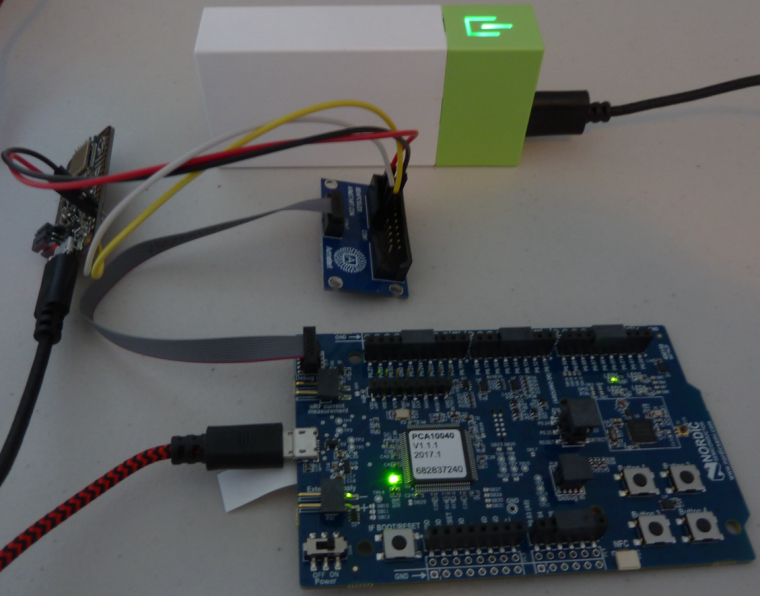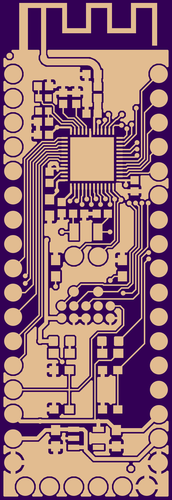nRF5 action!
-
@NeverDie said in Minimalist SAMD21 TQFP32 Pro Mini:
OK, I'll try that. Which of those 4 Zadig usb drivers should I pick?
Open the windows device manager and pull/plug the device and remove all depending drivers with option to uninstall the drivers.
-
Has anyone noticed that a bunch of cheap Chinese "smart bands" use a nrf51822 ?
This opens some new possibilities if used as MySensors actuator !
https://www.youtube.com/watch?v=SBHyQ1OSM-4@Nca78 said in Minimalist SAMD21 TQFP32 Pro Mini:
Has anyone noticed that a bunch of cheap Chinese "smart bands" use a nrf51822 ?
This opens some new possibilities if used as MySensors actuator !
https://www.youtube.com/watch?v=SBHyQ1OSM-4 -
next nice board with NRF 52832
-
@d00616
Right. But after that, which of the four do I re-install from Zadig? Or, am I misunderstanding?@NeverDie said in Minimalist SAMD21 TQFP32 Pro Mini:
Right. But after that, which of the four do I re-install from Zadig? Or, am I misunderstanding?
The CDC and BULK interface. All other are other Hardware.
-
FWIW, I ran across another example of where someone is using the DK to program an external nRF5 board:

(https://github.com/electronut/ElectronutLabs-bluey/blob/master/nRF52-DK-prog.md)
Unfortunately, that photo is also roughly the extent of their documentation, though they do spell out the pin mapping and tell which Linux commands to use. -
FWIW, I ran across another example of where someone is using the DK to program an external nRF5 board:

(https://github.com/electronut/ElectronutLabs-bluey/blob/master/nRF52-DK-prog.md)
Unfortunately, that photo is also roughly the extent of their documentation, though they do spell out the pin mapping and tell which Linux commands to use.I tried wiring it up as shown in the photos to the Adafruit nRF52832 and doing a programming through the DK and the Arduino IDE, but as you would expect it just programmed the nRF52832 that's on the DK and not the Adafruit. So, either there's a jumper that needs to be set, or different software is required to program an off-board nRF52832.
-
Well, I found this in the user manual of the DK, which sounds quite encouraging:
The nRF52 Development Kit board supports programming and debugging nRF51 and nRF52 devices mounted on external boards. To debug an external board with SEGGER J-Link OB IF, connect to the Debug out connector (P19) with a 10 pin cable. Figure 22: Debug output connector
When the external board is powered, the interface MCU will detect the supply voltage of the board and program/debug the target chip on the external board instead of the on-board nRF52832.
Important: The voltage supported by external debugging/programming is 3.0 V.
You can also use P20 as a debug out connection to program shield mounted targets. For the Debug out header (P19),the Interface MCU will detect the supply voltage on the mounted shield and program/debug the shield target.So, I'll try powering the off-board nrf52832 separately and see if it then works as described.
-
Well, I found this in the user manual of the DK, which sounds quite encouraging:
The nRF52 Development Kit board supports programming and debugging nRF51 and nRF52 devices mounted on external boards. To debug an external board with SEGGER J-Link OB IF, connect to the Debug out connector (P19) with a 10 pin cable. Figure 22: Debug output connector
When the external board is powered, the interface MCU will detect the supply voltage of the board and program/debug the target chip on the external board instead of the on-board nRF52832.
Important: The voltage supported by external debugging/programming is 3.0 V.
You can also use P20 as a debug out connection to program shield mounted targets. For the Debug out header (P19),the Interface MCU will detect the supply voltage on the mounted shield and program/debug the shield target.So, I'll try powering the off-board nrf52832 separately and see if it then works as described.
Success! Got Blink compiled and uploaded to the Adafruit nRF52832 Feather using the nRF52832 DK.
BTW, the adafruit LED works the opposite of the DK LED: on the Adafruit (as with most Arduino's), LOW means OFF, and HIGH means ON. For some reason the DK is the opposite of that.
-
Here is a photo to document the solution which worked:

For some reason the wiring shown in the Sparkfun and Bluey photos using header P20 didn't work for me, but using the ten pin P19 header, in combination with externally powering the Adafruit nRF52832 Feather, did work. :) So far, this is the only solution I've found which works from the Microsoft Windows environment using the Arduino IDE. So, this is what I'm going to move forward with. -
So, I have the Mysensors Light Sensor demo sketch running now on the Adafruit. I'm sorry to report though that the range is not good. Not sure why. Maybe it's that chip antenna Adafruit is using on its nRF52 Feather? Now that I know this, I won't be buying any more of them.
-
So, I have the Mysensors Light Sensor demo sketch running now on the Adafruit. I'm sorry to report though that the range is not good. Not sure why. Maybe it's that chip antenna Adafruit is using on its nRF52 Feather? Now that I know this, I won't be buying any more of them.
-
@NeverDie Good work, I am glad you have successfully programmed a chip from the DK.
Do you think we should open a new thread devoted to all of this Bluetooth action?
@Terrence said in Bluetooth action!:
@NeverDie Good work, I am glad you have successfully programmed a chip from the DK.
Do you think we should open a new thread devoted to all of this Bluetooth action?
Meh, I'll leave that up to the moderator. Meanwhile, I changed this thread's title to match your catch phrase.
-
next nice board with NRF 52832
@MiKa said in nRF5 Bluetooth action!:
next nice board with NRF 52832
Thanks for your post! Looks as though they have some very nice tutorials to go with it. That really sets it apart and makes it much more desirable.
Perhaps most significant of all: it claims it can be "programmed and debugged wirelessly"! Well, that makes sense, given the nature of its language.
-
Success! Got Blink compiled and uploaded to the Adafruit nRF52832 Feather using the nRF52832 DK.
BTW, the adafruit LED works the opposite of the DK LED: on the Adafruit (as with most Arduino's), LOW means OFF, and HIGH means ON. For some reason the DK is the opposite of that.
@NeverDie said in nRF5 Bluetooth action!:
BTW, the adafruit LED works the opposite of the DK LED: on the Adafruit (as with most Arduino's), LOW means OFF, and HIGH means ON. For some reason the DK is the opposite of that.
Maybe it is like the esp32 that the led is connected to vcc and not to gnd
-
@Terrence said in Bluetooth action!:
@NeverDie Good work, I am glad you have successfully programmed a chip from the DK.
Do you think we should open a new thread devoted to all of this Bluetooth action?
Meh, I'll leave that up to the moderator. Meanwhile, I changed this thread's title to match your catch phrase.
-
Looks as though the nRF52832 sparkfun board has more of a conventional trace antenna:

though isn't it somewhat odd that it appears to also be directly connected to the ground plane(?), or at least a copper pour. Is that normal? This was one of the images produced by sending their .BRD file to oshpark, so that I could get a look at the antenna. -
Please, take a look at the Soc version, only 3,33,10,5 ... Ok it is a Soc version ...
but unbelievable ....
BR
JP
Same question for WIFI bgn and bng/ac ... including a low power CortexM4F also ? -
Please, take a look at the Soc version, only 3,33,10,5 ... Ok it is a Soc version ...
but unbelievable ....
BR
JP
Same question for WIFI bgn and bng/ac ... including a low power CortexM4F also ?@jpb said in nRF5 Bluetooth action!:
Please, take a look at the Soc version, only 3,33,10,5 ... Ok it is a Soc version ...
but unbelievable ....
BR
JP
Same question for WIFI bgn and bng/ac ... including a low power CortexM4F also ?@jpb
Nice, but for present purposes the problem is that it doesn't use a Nordic nRF5. The existing mysensors development release doesn't support bluetooth per se, but rather the nRF24-type modes of the nRF5 chip. A chip from a non-Nordic chip manufacturer wouldn't support those modes.What will be interesting is if/when mysensors does in some way support bluetooth proper, at which point maybe some kinds (?) of bluetooth interactions with non-nordic bluetooth devices may be possible. Nordic has a bluetooth stack available for use on its nRF5 chips, and so it's ripe for integration.
-
For people who like coincell motes, this type of PCB design should be easy to put together:
https://www.aliexpress.com/item/iBeacon-Module-Bluetooth-4-0-BLE-Support-Near-field-Positioning-Sensor-Wireless-Acquisition/2049663760.html?spm=2114.search0104.3.32.DOxJ8e&ws_ab_test=searchweb0_0,searchweb201602_4_10152_10065_10151_10068_10130_10084_10083_10080_10082_10081_10110_10178_10137_10111_10060_10112_10113_10155_10114_10154_438_10056_10055_10054_10182_10059_100031_10099_10078_10079_10103_10073_10102_5360020_10189_10052_10053_10142_10107_10050_10051-normal#cfs,searchweb201603_1,ppcSwitch_4&btsid=4fa0fbcf-4595-46be-bd67-15faeeec2be5&algo_expid=f9915ec2-6be8-4ffb-aa7c-5da25d04f4a1-4&algo_pvid=f9915ec2-6be8-4ffb-aa7c-5da25d04f4a1
